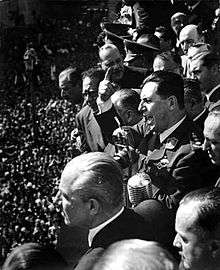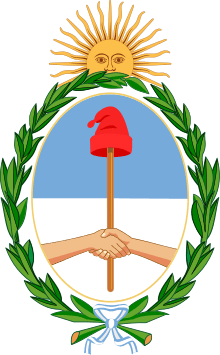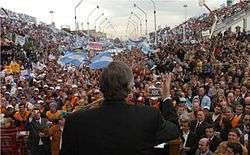Peronism
| Part of a series on |
| Populism |
|---|
|
People
|
|
Related topics |
|


Peronism (Spanish: Peronismo), or Justicialism (Justicialismo), is an Argentine political movement based on the political legacy of former President Juan Domingo Perón and his second wife, Eva Perón. The Justicialist Party (Partido Justicialista) derives its name from the concept of social justice (Spanish: justicia social).
Since its inception in 1946, Peronist candidates have won 9 of the 12 presidential elections from which they have not been banned. As of 2016, Perón was the only Argentine to have been elected president three times.
Overview
The pillars of the Peronist ideal, known as the "three flags", are social justice, economic independence, and political sovereignty. Peronism can be described as a third position ideology, as it rejects both capitalism and communism. Peronism espouses corporatism and thus aims to mediate tensions between the classes of society, with the state responsible for negotiating compromise in conflicts between managers and workers.
It is, however, a generally ill-defined ideology; different, and sometimes contradictory sentiments are expressed in the name of Peronism. Today, the legacy and thought of Perón have transcended the confines of any single political party and bled into the broader political landscape of Argentina, therefore Peronists are usually described as a political movement. Traditionally the Peronist movement has drawn its strongest support from the working class and sympathetic unions, and has been characterized as proletarian in nature.
From the perspective of opponents, Peronism is an authoritarian ideology. Perón was often compared to fascist dictators, accused of demagoguery, and his policies derided as populist. Proclaiming himself the embodiment of nationality, Perón's government often silenced dissent by accusing opponents of being unpatriotic. The corporatist character of Peronism drew attacks from socialists who accused his administration of preserving capitalist exploitation and class division. Conservatives rejected its modernist ideology and felt their status threatened by the ascent of the Peronist apparat. Liberals condemned the Perón regime's arbitrariness and dictatorial tendencies.
Defenders of Peronism also describe the doctrine as populist, albeit in the sense that they believe it embodies the interests of the masses, and in particular the most vulnerable social strata. Admirers hold Perón in esteem for his administration's anti-imperialism, and non-alignment, as well as its socially progressive initiatives. Amongst other measures introduced by Perón’s governments, social security was made universal, while education was made free to all who qualified, and working students were given one paid week before every major examination. Vast low-income housing projects were created, and paid vacations became standard. All workers (including white-collar employees) were guaranteed free medical care and half of their vacation-trip expenses, and mothers-to-be received three paid months off prior to and after giving birth. Workers’ recreation centers were constructed all over the country, including a vast resort in the lower Sierras de Córdoba that included eight hotels, riding stables, swimming pools, movies, and scores of cabins.[1]
Perón's policies
Part of a series on the |
|---|
| History of Argentina |
 |
|
|
Post-WW II (1955 to 1976) |
|
Return to democracy |
|
|
Perón's ideas were widely embraced by a variety of different groups in Argentina across the political spectrum. Perón's personal views later became a burden on the ideology; for example, his anti-clericalism did not strike a sympathetic chord with upper-class Argentinians.
Peronism is widely regarded as a form of corporate socialism, or "right-wing socialism".[2] Perón's public speeches were consistently nationalist and populist. It would be difficult to separate Peronism from corporate nationalism, for Perón nationalized Argentina's large corporations, blurring distinctions between corporations and government. At the same time, the labor unions became corporate, ceding the right to strike in agreements with Perón as Secretary of Welfare in the military government from 1943–45. In exchange, the state was to assume the role of negotiator between conflicting interests.
Peronism also lacked a strong interest in matters of foreign policy other than the belief that the political and economic influences of other nations should be kept out of Argentina; he was somewhat isolationist. Early in his presidency, Perón envisioned Argentina's role as a model for other countries in Latin America and beyond. Such ideas were ultimately abandoned. Despite his oppositional rhetoric, Perón frequently sought cooperation with the United States government on various issues.[3]
Criticism of Perón
Perón and his administration resorted to organized violence and dictatorial rule. Perón showed contempt for any opponents, and regularly characterized them as traitors and agents of foreign powers. Perón maintained the institutions of democratic rule, but subverted freedoms through such actions as nationalizing the broadcasting system, centralizing the unions under his control, and monopolizing the supply of newspaper print. At times, Perón also resorted to tactics such as illegally imprisoning opposition politicians and journalists, including Radical Civic Union leader Ricardo Balbin, and shutting down opposition papers, such as La Prensa.
Perón's admiration for Benito Mussolini is well documented.[4] Many scholars categorize Peronism as a fascist ideology.[5] Carlos Fayt believes that Peronism was just "an Argentine implementation of Italian fascism".[5] Hayes reaches the conclusion that "the Peronist movement produced a form of fascism that was distinctively Latin American".[5]
One of the most vocal critics of Peronism was the Argentine writer Jorge Luis Borges. After Perón ascended to the presidency in 1946, Borges spoke before the Argentine Society of Writers (SADE), saying
"Dictatorships breed oppression, dictatorships breed servility, dictatorships breed cruelty; more loathsome still is the fact that they breed idiocy. Bellboys babbling orders, portraits of caudillos, prearranged cheers or insults, walls covered with names, unanimous ceremonies, mere discipline usurping the place of clear thinking... Fighting these sad monotonies is one of the duties of a writer. Need I remind readers of Martín Fierro or Don Segundo that individualism is an old Argentine virtue."[6]
Attitudes towards Jews
Perón's ideology was economic and political in character and did not have the racism of Nazi Germany.
Before Perón came to power in Argentina, Argentina had the largest Jewish population in Latin America. After becoming president, he invited members of the Jewish community to participate in his government. One of his advisors was José Ber Gelbard, a Jewish man from Poland. Peronism did not have anti-Semitic or other racial bias.[7] The Jewish Virtual Library writes that while Juan Perón had sympathized with the Axis powers, "Perón also expressed sympathy for Jewish rights and established diplomatic relations with Israel in 1949. Since then, more than 45,000 Jews have immigrated to Israel from Argentina."[8]
In the book Inside Argentina from Perón to Menem author Laurence Levine, former president of the US–Argentine Chamber of Commerce, writes: "although anti-Semitism existed in Argentina, Perón's own views and his political associations were not anti-Semitic".[9] While Perón allowed many Nazi criminals to take refuge in Argentina, he also attracted many Jewish immigrants. Argentina has a Jewish population of over 200,000 citizens, the largest in Latin America and one of the largest in the world.[10]
Peronism after Perón
The fall of Perón
A military and civilian coup, the Revolución Libertadora, led by General Eduardo Lonardi, overthrew the Perón regime in 1955. During the coup, Lonardi drew analogies between Perón and Juan Manuel de Rosas. Lonardi used the quote "ni vencedores ni vencidos" (Spanish: "neither victors nor vanquished"), which was used by Justo José de Urquiza after deposing Rosas in the battle of Caseros. The official perspective was that Perón was "the second tyranny", the first one being Rosas, and that both ones should be equally rejected, and conversely both governments that ousted them should be praised. For this end they draw the line of historical continuity "May – Caseros – Libertadora", matching the coup with the May Revolution and the defeat of Rosas. This approach backfired. Perón was highly popular and the military coup unpopular; so Peronists embraced the comparison established between Rosas and Perón, but viewing him with a positive light instead.[11] Nationalist historians draw then their own line of historical continuity, "San Martín – Rosas – Perón".[12]
The absence of Perón, who lived for 16 years in exile in Francoist Spain, is an important key to understanding Peronism. After he went into exile, he could be invoked by a variety of Argentine sectors opposed to the current state of affairs. The personality cult of Eva Perón, in particular, was conserved by supporters, while despised by the "national bourgeoisie". In the 1960s, John William Cooke's writings became an important source of left-wing revolutionary Peronism. Left-wing Peronism was represented by many organizations, from the Montoneros and the Fuerzas Armadas Peronistas to the Peronist Youth, the Frente Revolucionario Peronista and the Revolutionary Peronist Youth, passing by Peronismo en Lucha or Peronismo de Base, which supported a Marxist viewpoint.[13]
On the other hand, older Peronists formed the base of the orthodox bureaucracy, represented by the Unión Obrera Metalúrgica (Augusto Vandor, famous for his 1965 slogan "For a Peronism without Perón," and declaring as well: "to save Perón, one has to be against Perón", or José Ignacio Rucci). Another current was formed by the "62 Organizaciones 'De pie junto a Perón'", led by José Alonso and opposed to the right-wing Peronist unionist movement. In the early 1970s, left-wing Peronism rejected liberal democracy and political pluralism as the mask of bourgeois domination. The anti-communist right-wing Peronism also rejected it, in the name of corporatism, claiming to return to a "Christian and humanist, popular, national socialism".[13]
By 1970, many groups from opposite sides of the political spectrum had come to support Perón, from the left-wing and Catholic Montoneros to the fascist-leaning and strongly anti-Semitic Tacuara Nationalist Movement, one of Argentina's first guerrilla movements. In March 1973, Héctor José Cámpora, who had been named as Perón's personal delegate, was elected President of Argentina. A few months after Perón's return and the subsequent Ezeiza massacre, during which the Peronist Left and Right violently clashed, new elections were held in September.[13]
José Cámpora, a left-wing Peronist, was replaced by interim President Raúl Alberto Lastiri, while Perón chose to openly support the Peronist right. On October 1, 1973, senator Humberto Martiarena, who was the national secretary of the Superior Council of the National Justicialist Movement, publicized a document giving directives to confront "subversives, terrorist and Marxist groups" which had allegedly initiated a "war" inside the Peronist organizations.[13] From then on, the Superior Council took a firm grip on the Peronist organizations to expel the Left from it.[13]
On that same day, a meeting took place among President Raúl Lastiri, Interior Minister Benito Llambí, Social Welfare Minister José López Rega, general secretary of the Presidency José Humberto Martiarena and various provincial governors, which has been alleged to have been the foundational act of the Argentine Anticommunist Alliance death-squad.[14]
Menem years

The official Peronist party is the Justicialist Party (PJ), which was the only Peronist party for a long time. During the government of Carlos Menem a group of legislators led by Carlos Álvarez, known as the "Group of 8", left the party, claiming that the government was not following Peronist doctrines. They created a new party, the Broad Front.
A short time later, José Octavio Bordón left the PJ as well, fearing that he might lose a primary election against Menem, so he created his own party to take part in the 1995 elections, and allied with Álvarez' Broad Front in the Front for a Country in Solidarity (Frepaso) coalition. Similar breakaway movements followed frequently after that, creating many small parties which were led by single politicians claiming to be the authentic inheritors of Peronism.
Kirchnerism
The PJ did not participate as such during the 2003 elections. The party allowed all three precandidates to run for the general elections, using small parties created for that purpose. Néstor Kirchner won the elections running on a Front for Victory ticket. As he did not disband his party after the election, Kirchnerism relies on both the PJ and the Front for Victory.
In 2004 Chilean Christian Democrat Ignacio Walker wrote a column in El Mercurio criticizing Peronism stating it had "Fascistoid", "authoritarian" and "corporative" traits. He added that "I tend to think the real wall that separes Chile from Argentina is not the Andes but the legacy of Peronism and its perverse logic".[15] A few months after Walker had written this column he was appointed chancellor and the surfacing of his previous statements caused a diplomatic impasse between Chile and Peronist-ruled Argentina. A similar situation happened again in 2006 when it was made known that Chilean minister Andrés Velasco had referred to some Peronist leaders as having "fascist traits" and had supported Walker's analysis in 2004.[16]
See also
General:
References
- ↑ http://www.columbia.edu/~lnp3/mydocs/state_and_revolution/Juan_Peron.htm
- ↑ Buenos Aires Journal The New York Times Jan 13, 1990
- ↑ "Chronicle of an Inconclusive Negotiation: Perón, the International Monetary Fund, and the World Bank (1946–1955)". Hispanic American Historical Review. 92.
- ↑ Eatwell, Roger (1999). Contemporary Political Ideologies. Continuum International Publishing Group. p. 196. ISBN 978-0-8264-5173-6.
- 1 2 3 Peronism and Argentina, James P. Brennan, Rowman & Littlefield, 1998]
- ↑ Borges: A Life, page 295.
- ↑ Crassweller, David. Perón and the Enigmas of Argentina. W.W. Norton and Company. 1987: 221. ISBN 0-393-30543-0
- ↑ Weiner, Rebecca: Post World War II at Jewish Virtual Library
- ↑ Levine, Laurence: Inside Argentina from Perón to Menem: 1950–2000 From an American Point of View, p. 23.
- ↑ "Continuing Efforts to Conceal Anti-Semitic Past." Valente, Marcela. IPS-Inter Press Service. April 27, 2005
- ↑ Devoto, pp. 278–281
- ↑ Chaneton, p. 37
- ↑ Manuel Justo Gaggero, “El general en su laberinto”, Pagina/12, 19 February 2007
- ↑ Walker, Ignacio (May 6, 2004). "Ignacio Walker: "Nuestros vecinos argentinos"". El Mercurio. Santiago, Chile. Retrieved May 26, 2014.
- ↑ "Resurgen en Argentina polémicos dichos de Velasco sobre el peronismo". El Mercurio. Santiago, Chile. March 20, 2006. Retrieved May 26, 2014.
Bibliography
- Tomas Eloy Martinez, El Sueño Argentino' (The Argentine Dream, 1999) and Memorias del General (Memoirs of the General, 1996).
- Daniel James, Resistance and Integration: Peronism and the Argentine Working Class, 1946-1979. NY: Cambridge University Press, 1988.
- Félix Luna, Perón y Su Tiempo, Vol I-III.: Sudamericana, 1990.
